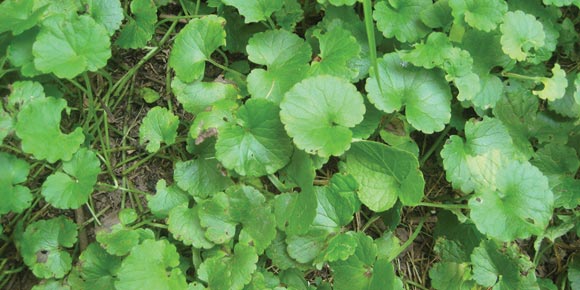Creeping Charlie invades lawns, driving the lawn perfectionist crazy. It has rounded, one-inch to one-and-a-quarter-inch leaves with scalloped edges. It grows close to the ground and sends out stolons that occur on both stems and roots. Stolons are shoots from the mother plant that form roots at its nodes, allowing the plant to spread quickly. The leaves may be variegated. In springtime it sends up pretty, two-lipped, bluish-purple flowers that produce lots of seeds, if you let them.
Creeping Charlie (Glechoma hederacea) is a member of the mint family and has the square stems to prove it. It has many other names, including ground ivy, creeping jenny, gill-over-the-ground, alhhoof, tunfoot, cat’s foot field balm, and runaway robin, to name just a few.
Like so many other invasive weeds, Creeping Charlie was imported for its virtues from Europe, where it was used to treat eye inflammation, ringing in the ears (tinnitus), and as a diuretic. Essential oils from the plant were used as a general tonic and to treat colds, coughs and to relieve congestion. It was also used against stomach ailments.
“Dried leaves may be snuffed up the nose to relieve headache,” says one herbalist. A poultice of the stuff treated bruises and black eyes. It was also used to relieve sciatica (an ache in the huckle bone, says an ancient herbalist). It has also been used in place of animal fat rennet to make cheese. Rennet is a complex set of enzymes produced in the stomachs of mammals to help coagulate milk, separating it into curds and whey.
Full of vitamin C
Creeping Charlie is chock full of vitamin C and other helpful ingredients. It’s good for salads where it imparts a tangy taste (remember it is a member of the mint family), but it’s also been used to make tea, added to stews, soups and omelets and, before hops came on the scene, was an ingredient in beer where it imparted flavour and preservative quality.
This plant will grow well in a shady spot with rich soil and lots of moisture, but it doesn’t object to a fair amount of sunshine, either. It thrives in low boron content soil and is very sensitive to boron, so one remedy is to increase the boron content in your soil.
This takes very specific instruction because too much boron can kill everything in its vicinity. The commercially available product, Borax, is basically boron. Dissolve 8 to 10 ounces of Borax in 4 ounces (125 mL) water. Then dilute this substance with 10 litres of water. Spray this evenly on 1,000 square feet of infested lawn. Be precise about your measurements and your target. Boron is toxic to other plants at higher concentrations. Borax does not break down, as it is an element, although time and rain water may cause it to leach away. There are also commercial weed killers.
If you are nervous about collateral damage from chemicals, you can pull the plant early in spring when the ground is still wet and friable; the roots will come out easily. Deeply embedded stoloniferous roots may still pose a problem though and you may have to dig deeper. Another remedy, and probably the safest and easiest, is to deprive the plant of light by laying wet newspaper over it for a month or so. You will also kill the grass, but you can always reseed.
And if all else fails, creeping Charlie can provide a pretty alternative in areas where grass is difficult to grow.



